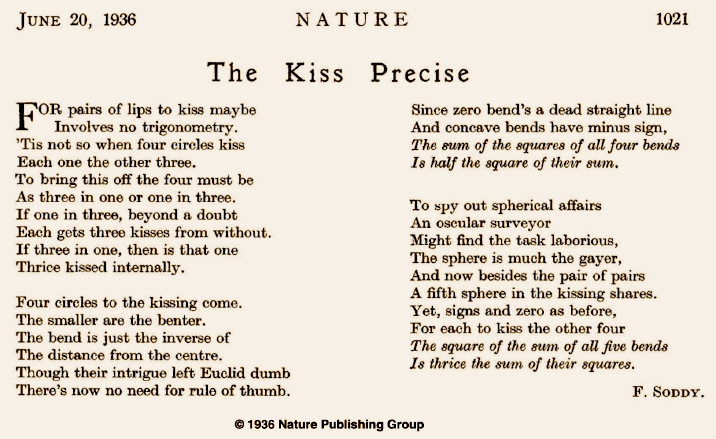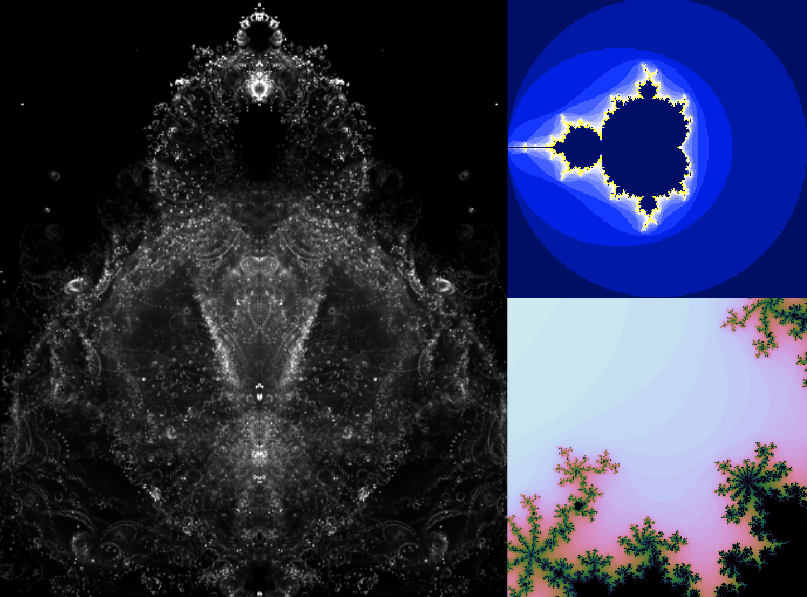The Kiss Precise
A long-form, Solidity-generated NFT collection based on the Apollonian Gasket, from @divergence_art & @etheseus_art
Mint now
Each Kiss NFT will be generated from a random
seed—set at the time of
minting—which in turn determines its
colours, layout, and density. In the meantime,
you can try any alpha-numeric string here to see
what the smart contract generates, live from
New York the blockchain.
The Problem of Apollonius is deceptively simple, but steeped in mathematical history. The most famous version asks: given any three ‘kissing circles’ (tangent to one another), find a fourth circle that is tangent to the other three.
The problem was proposed (and possibly solved) by the Greek mathematician Apollonius of Perga in the 3rd century BC. However, Apollonius' writings were lost to history. We only have commentaries on the original texts by ancient mathematicians like Pappus of Alexandria, dated over 400 years later. Over the millennia that followed, some of the greatest mathematical minds have been drawn to Apollonius' problem including Newton, Leibniz and Euler. Newton's approach, using trilateration and hyperbolic geometry, would later underpin GPS navigation systems.
The most famous solution came in the 17th century, in a letter from French mathematician René Descartes to Princess Elisabeth of Bohemia. His elegant algebraic solution (Descartes' Theorem) was also forgotten by history, only to be rediscovered independently by both Steiner and Beecroft in the 19th century. Fifty years later, Frederick Soddy (incidentally a Nobel prize-winning chemist) proposed the solution yet again in poetic form. Published in Nature in 1935, his poem lends its name to our collection. Ever since, the problem has continued to influence cutting edge research in algebraic topology and group theory.
After centuries of being forgotten, our collection encodes the Apollonius Problem on the Ethereum blockchain. We harness it to generate versions of the famous Apollonian Gasket—a cascading vortex of kissing circles that pushes the boundaries of generative art in Solidity.

There are 1024 Kiss NFTs available, minting at 0.314159 ETH (π/10). Brotchain NFT holders receive a discounted price of 0.256 ETH per Brot; PROOF OF {ART}WORK holders receive a discounted price of 0.256 ETH with a free Kiss (mint one, get one free) per PO{A}W NFT.
Advance minting for eligible wallets will begin at 20:00 UTC (15:00 EST, 12:00 PT) on 11 February. This will be available to Brotchain and PO{A}W holders, as well as competition winners and recipients of mint-spot giveaways for partnering NFT collections. Twenty pieces will be minted without charge by the creators.
Open minting will begin at 20:00 UTC (15:00 EST, 12:00 PT) on 14 February, Valentines Day.
We will offer authenticated art prints for owners, starting shortly after the drop (exact date TBC, as we are still setting up the logistics and tech to handle this). Only one authenticated print will be made for each NFT.
10% of all minting proceeds will be set aside. We'll use this to first make the collection carbon-neutral (including predicted post-mint transactions), before donating the remainder to STEM education charities.
Divergence (Arran and Harri) are best known in the NFT world for pushing Solidity art boundaries with their in-chain project Brotchain, as well as the interactive, mathematically-driven PROOF OF {ART}WORK collection. They have also collaborated with other artists on a number of collections including Every Icon (with John F Simon Jr, Fingerprints and e∙a∙t∙}works) and Glitchy Bitches. Their open-source smart contract templates and Ethereum development environment, ethier, has been used in drops for Kevin Rose and XCOPY's Grifters, amongst others.
Etheseus is a physicist and digital artist, interested in generative collections that draw on the history of mathematics and philosophy. The name references the Ship of Theseus—a philosophical dilemma about identity and change. Close friends with Arran and Harri in the meatverse, this is Etheseus' debut NFT collection.

The Kiss is fundamentally a very simple algorithm with beautiful results. We wanted to mirror this elegance in our implementation—creating an artwork that is as attractive on the inside as it is on the outside.
The choice to use Solidity goes a long way towards achieving this, as the Ethereum Virtual Machine already strips computing back to raw building blocks—integers, basic mathematical operators, bit manipulation, and control structures like loops and if-statements. While it meant creating bit-wise implementations of Descartes' theorem, including complex-number square roots, the result is much “purer” than if we had relied on the abstraction most modern hardware and programming languages offer.
In addition, Apollonian circle packing typically uses recursive functions that call upon their own implementation to achieve self-similar images. We felt this relied on software constructs at odds with the self-sufficient nature of the algorithm—so instead The Kiss implements its own call stack, allowing the same outcome to be reached in a single loop.
The basic construction randomly partitions circles along their diameter before deterministically packing the remaining space as per Appollonius' problem. Density and partition depth are controlled by each NFT's random seed to create significant diversity between pieces. In addition, there are a number of special topological traits, including but not limited to:
Gravity
Pappus chaining
Overflow
Horizontal
Each piece's palette is chosen at random from a set of 12 pre-defined colour sets, each with its own probability of selection. The palettes are not fixed, but specify probability distributions from which the background, midground and foreground colors are sampled.
Each palette is named after a mathematician whose work overlaps with the mathematics of the Apollonian gasket. Some have contributed directly to its formulation, others built upon it and applied it in new domains of mathematics, others still have had their work converge with circle packing posthumously.
Hypatia
Hypatia of Alexandria, c. 350-415 AD
Descartes
René Descartes, 1596-1650
Mobius
August Mobius, 1790-1868
Riemann
Bernhard Riemann, 1826-1866
Klein
Felix Klein, 1849-1925
Soddy
Frederick Soddy, 1877-1956
Noether
Emmy Noether, 1882-1935
Keen
Linda Keen, 1940-
Series
Caroline Series, 1951-
Oh
Hee Oh, 1969-
Mirzakhani
Maryam Mirzakhani, 1977-2017
Blueprint Collection